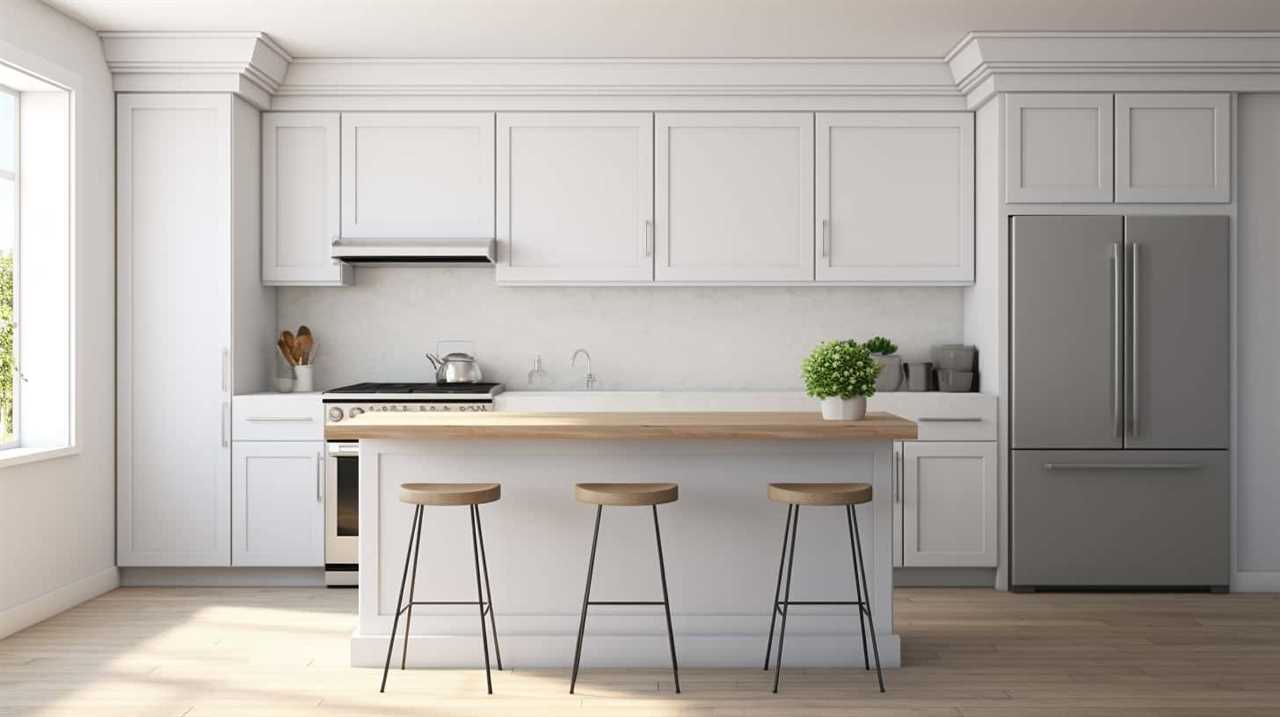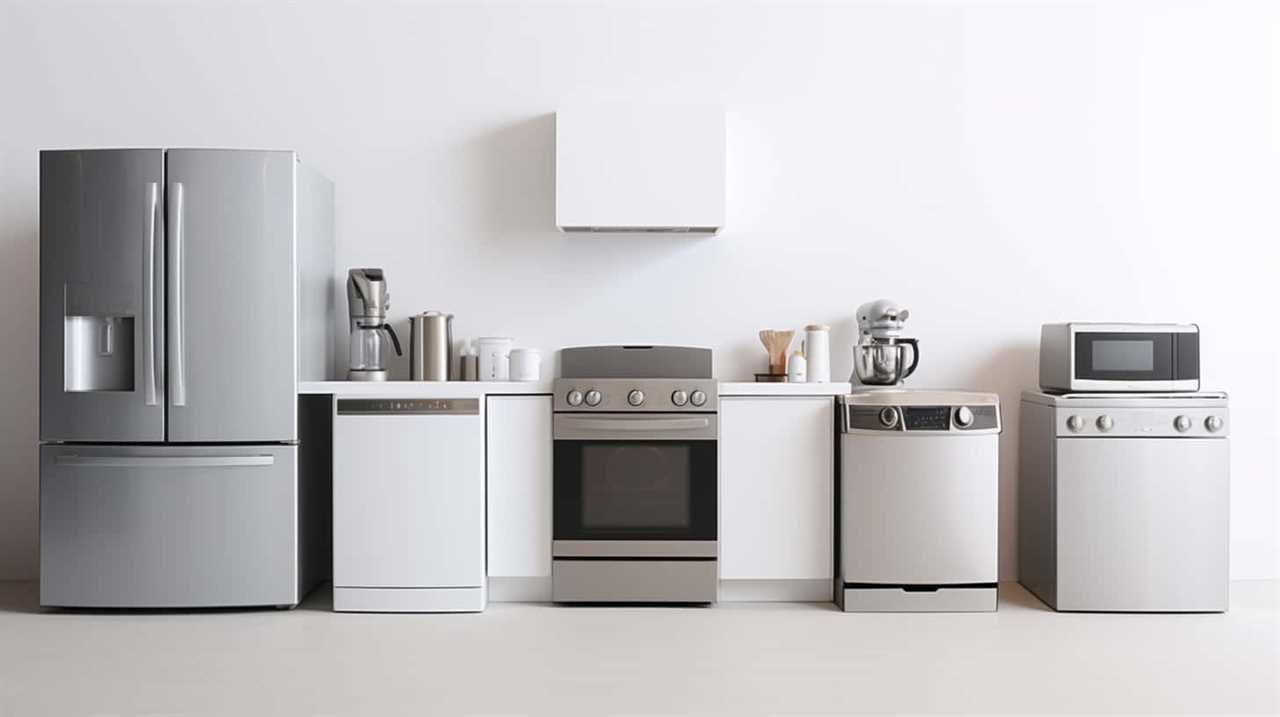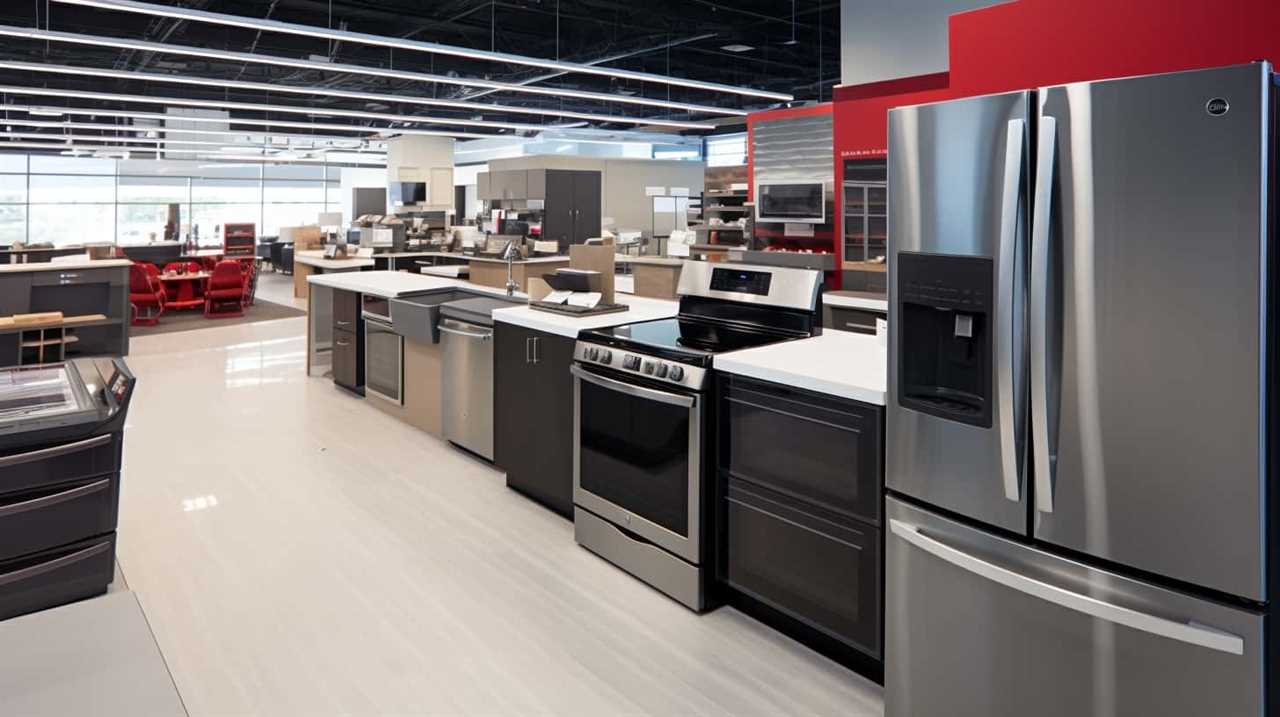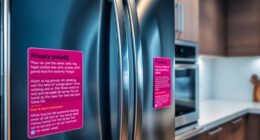Just picture the thrill of traveling to a new location, only to discover that you left your favorite gadgets at home. It’s a common experience for many of us.
But fear not, fellow travelers! In this article, we’ll explore the ins and outs of bringing appliances on a plane. From TSA regulations to size and weight restrictions, we’ve got you covered.
So sit back, relax, and let us guide you through the world of hassle-free appliance transportation.
Key Takeaways
- Small appliances like hair dryers, electric shavers, and curling irons are generally allowed in carry-on luggage.
- Larger appliances such as electric grills or portable stoves are usually prohibited.
- Battery-powered appliances like laptops or smartphones are allowed as long as they comply with airline rules.
- Regulations vary depending on the airline and type of appliance.
Types of Appliances Allowed on Planes
We can bring certain types of appliances on a plane when traveling for recreational purposes. However, there are restrictions on battery-powered appliances due to safety reasons. It’s important to note that these regulations vary depending on the airline and the type of appliance.

Generally, small appliances like hair dryers, electric shavers, and curling irons are allowed in carry-on luggage. These items are considered safe as they typically don’t have large batteries or potentially hazardous components.
On the other hand, larger appliances such as electric grills or portable stoves are usually prohibited due to their size and potential fire hazards. Battery-powered appliances like laptops or smartphones are generally allowed as long as they comply with the airline’s rules regarding lithium-ion batteries.
It’s always best to check with your airline before bringing any appliances on board to avoid any issues during your travel.
TSA Regulations for Carrying Appliances
When traveling with appliances, it’s important to be aware of the TSA regulations for carrying them. The Transportation Security Administration (TSA) has specific guidelines in place to ensure the safety and security of all passengers.

When it comes to bringing small appliances on a plane, there are a few things to keep in mind. First, appliances that contain lithium batteries, such as laptops or smartphones, must be carried in your carry-on luggage. This is because lithium batteries can pose a fire hazard when stored in the cargo hold.
Additionally, appliances that are considered hazardous materials, such as propane stoves or fuel-powered generators, aren’t allowed on board.
It’s always a good idea to check with the TSA website or contact your airline directly for the most up-to-date information on TSA guidelines for appliances.
Carrying Appliances in Carry-On Luggage
Appliances can be brought on a plane in your carry-on luggage. It’s important to note that this refers to smaller appliances, as carrying large appliances in your carry-on isn’t feasible.

When packing appliances in your carry-on, there are a few restrictions to keep in mind. Here are three key points to consider:
- Size and weight: Ensure that the appliance fits within the size and weight restrictions set by the airline. Typically, carry-on items shouldn’t exceed a certain size and weight limit.
- Packaging: Make sure the appliance is properly packaged to prevent any damage during transit. This may include using bubble wrap, foam padding, or placing it in a sturdy container.
- Power source: If your appliance requires a power source, such as batteries or an electrical outlet, it’s important to check with the airline about any restrictions or guidelines for carrying such items.
Carrying Appliances in Checked Luggage
Our checked luggage allowance permits a limited number of appliances to be included for transport on a plane.
While carrying small appliances in checked luggage is generally allowed, it’s important to adhere to certain guidelines to ensure a smooth travel experience.
Small appliances such as hair dryers, electric razors, and portable speakers can be safely packed in your checked luggage. However, it’s recommended to pack them securely to prevent any damage during transit.

On the other hand, transporting large appliances in checked luggage isn’t feasible due to their bulky nature. These appliances are better suited for ground transportation or shipping services.
It’s crucial to check with your airline regarding their specific regulations and restrictions on carrying appliances in checked luggage to avoid any inconvenience at the airport.
Size and Weight Restrictions for Appliances
Now let’s talk about the size and weight restrictions for appliances when it comes to bringing them on a plane.
Airlines have specific guidelines in place to ensure that the appliances you bring on board are safe and won’t cause any inconvenience to other passengers. These guidelines usually include maximum allowable dimensions for appliances, as well as weight limits to prevent any strain on the aircraft.

It’s important to familiarize yourself with these restrictions before packing your appliances to avoid any issues at the airport.
Maximum Allowable Dimensions
After checking the airline’s guidelines, we discovered the maximum allowable dimensions for appliances when traveling by plane. It’s crucial to know these restrictions to avoid any unwanted surprises at the airport. Here are the three key points to keep in mind:
- Maximum Weight:
Airlines typically have a weight limit for appliances, which can vary depending on the carrier. It’s important to check the specific guidelines for your chosen airline to ensure you stay within the allowed weight range. - Size Restrictions:
Appliances must also adhere to certain size restrictions. This includes both the length, width, and height of the item. Airlines often provide specific measurements that appliances mustn’t exceed to be allowed on board. - Special Considerations:
Some airlines may have additional requirements or considerations for certain types of appliances. For example, they may require that appliances are properly packaged or that their batteries are removed. It’s essential to familiarize yourself with any additional guidelines to ensure a smooth travel experience.
Weight Limits for Appliances
Let’s talk about the weight limits for appliances when bringing them on a plane.
When it comes to carrying kitchen appliances or any electronic devices, there are certain restrictions in place. Airlines usually have weight limits to ensure the safety and comfort of all passengers on board. These weight limits vary depending on the airline and the type of appliance you’re planning to bring.

It’s important to check with your airline beforehand to understand their specific regulations. Some airlines may allow you to bring small appliances as carry-on items, while others may require them to be checked in. In either case, be prepared to adhere to the weight restrictions imposed by the airline.
Now that we’ve covered weight limits, let’s move on to discussing the power source requirements for appliances.
Power Source Requirements for Appliances
We need to consider the power source requirements for appliances when deciding whether or not to bring them on a plane. Airlines have strict regulations regarding power source compatibility and appliance travel restrictions.
Here are three important factors to keep in mind:

- Voltage and Frequency: Different countries use different voltage and frequency standards. It’s crucial to check if your appliance is compatible with the electrical system at your destination. Using an incompatible power source can damage your appliance or even cause a safety hazard.
- Plug Types: The shape and size of electrical plugs vary across countries. Make sure your appliance’s plug is compatible with the outlets at your destination. If not, you may need to carry an adapter or converter to ensure a proper connection.
- Battery Restrictions: Airlines have specific rules for carrying batteries on board. Lithium-ion batteries, commonly used in laptops and other electronic devices, are subject to quantity limits and must be carried in your carry-on luggage. It’s essential to check the airline’s guidelines to avoid any issues during security checks.
Considering these power source requirements will help you determine whether it’s feasible to bring your appliances on a plane and ensure a smooth and hassle-free journey.
Packing Appliances Safely for Travel
To ensure the safe transport of appliances, it’s important to consider proper packing techniques and protective measures.
When traveling with appliances, it’s crucial to pack them securely to prevent any damage during the journey. Firstly, check the specific airline’s regulations regarding the types of appliances allowed on board. Some airlines may have restrictions on certain appliances due to safety concerns.
Secondly, consider the voltage compatibility of your appliances. Different countries may have different voltage standards, so it’s essential to ensure that your appliances are compatible with the voltage at your destination. This can be done by checking the voltage requirements of your appliances and using appropriate voltage converters if necessary.

By following these packing techniques and considering voltage compatibility, you can safely transport your appliances during travel.
Now, let’s move on to the next section and discuss how to ensure that your appliances are TSA compliant.
Ensuring Appliances Are TSA Compliant
How can we ensure that our appliances are TSA compliant when traveling on a plane?
Here are three important steps to follow:

- Research TSA Guidelines: Before packing your appliances, familiarize yourself with the Transportation Security Administration’s guidelines. They’ve specific rules on what can and can’t be brought on a plane. Pay close attention to the size, weight, and type of appliances allowed.
- Check Airline Policies: In addition to TSA guidelines, airlines may have their own restrictions on bringing kitchen appliances. Visit the airline’s website or contact their customer service to find out if there are any additional requirements or limitations.
- Secure Proper Packaging: When transporting large appliances, it’s crucial to ensure they’re securely packaged to prevent damage. Use sturdy boxes, bubble wrap, and padding to protect your appliances during transit. Additionally, consider disassembling any removable parts and packing them separately.
Additional Security Measures for Appliances
After ensuring our appliances are TSA compliant, we can take additional security measures to protect them during air travel. When it comes to packing appliances safely for travel, there are a few key steps to follow.
Firstly, make sure to securely wrap the appliance in bubble wrap or other protective material to prevent any damage during transit. It’s also a good idea to place the appliance in a sturdy, hard-sided suitcase or bag to provide extra protection. Additionally, consider removing any detachable parts and packing them separately to minimize the risk of damage. Lastly, always remember to label the package as fragile and handle with care.
By taking these additional security measures, we can ensure that our appliances arrive at our destination intact and ready to be used.
In the next section, we’ll discuss the appliances that are prohibited on planes and can’t be brought on board.

Appliances Prohibited on Planes
Now, let’s delve into the appliances that aren’t allowed on planes and can’t be brought on board. It’s important to be aware of these restrictions to avoid any inconvenience or potential security issues. Here are three types of appliances that are prohibited on planes:
- Appliances with power source requirements: Airlines typically don’t allow appliances that require a power source, such as generators or fuel-powered devices. These items pose a risk due to their potential to cause fires or explosions.
- International appliance types: Some appliances from other countries may not meet the safety standards or have the necessary certifications required for air travel. It’s crucial to check with the airline or relevant authorities before attempting to bring these appliances on board.
- Hazardous appliances: Appliances that are considered hazardous, such as cooking stoves, flammable gases, or explosive devices, are strictly prohibited on planes. These items pose serious safety risks and aren’t allowed in the cabin or checked luggage.
It’s always best to consult with the airline or refer to the Transportation Security Administration (TSA) guidelines to ensure compliance with appliance restrictions when traveling by plane.
Bringing Appliances for Medical Purposes
When it comes to bringing appliances on a plane, there are certain considerations to keep in mind, especially when it comes to bringing appliances for medical purposes. Medical appliance regulations are in place to ensure the safety and well-being of passengers, as well as to comply with international aviation standards.
Transporting medical devices requires careful planning and adherence to specific guidelines. It’s important to check with the airline beforehand to understand their specific policies and procedures regarding the transportation of medical appliances. Some airlines may require documentation, such as a doctor’s letter or a medical certificate, to verify the necessity of the appliance.

Additionally, it’s important to pack the appliance securely and ensure it’s easily accessible for inspection if required. With these considerations in mind, let’s now explore the regulations and guidelines for international travel with appliances.
International Travel With Appliances
When traveling internationally with appliances, there are several important points to consider.
Firstly, it’s crucial to be aware of the allowed types of appliances in the country you’re visiting, as regulations may vary.
Additionally, voltage compatibility is a key factor to keep in mind, as different countries have different electrical systems.

Lastly, it’s important to be mindful of packing and weight limits when traveling with appliances to avoid any issues at the airport.
Allowed International Appliance Types
We recommend researching the allowed types of appliances before traveling internationally with them. It’s important to familiarize yourself with the international appliance restrictions to ensure a hassle-free journey.
Here are three types of appliances that are generally allowed for international travel:
- Personal Care Appliances: Items like hair dryers, curling irons, and electric shavers are usually permitted in carry-on or checked luggage. Make sure to pack them securely to prevent any damage during transit.
- Kitchen Appliances: Small kitchen appliances, such as blenders, toasters, and coffee makers, are typically allowed in checked luggage. However, it’s essential to check the specific restrictions of your destination country to avoid any issues at customs.
- Medical Appliances: If you require medical devices, such as CPAP machines, nebulizers, or insulin pumps, you can usually bring them on board. It’s advisable to carry a doctor’s note and ensure they comply with international travel regulations.
Now that you know the allowed types of appliances, let’s delve into voltage compatibility considerations.

Voltage Compatibility Considerations
Moving on to voltage compatibility considerations for international travel with appliances, it’s important to ensure that your devices can safely operate with the electrical systems in your destination country. Different countries have different voltage standards, which can vary between 110-120 volts and 220-240 volts. To determine if your appliances are compatible, you can refer to the table below:
| Destination Country | Voltage Standard | Compatible Appliances |
|---|---|---|
| United States | 110-120V | Yes |
| United Kingdom | 220-240V | No |
| Germany | 220-240V | Yes |
If your destination country has a different voltage standard than your appliances, you may need to use a voltage converter. However, it’s important to note that voltage converters are not suitable for all devices and can potentially damage your appliances. It’s recommended to consult the manufacturer’s guidelines or seek professional advice before using voltage converters. Now that we’ve discussed voltage compatibility, let’s move on to the next section about packing and weight limits.
Packing and Weight Limits
Our airline’s policy on packing and weight limits for international travel with appliances is clear and straightforward. Here are three important things to keep in mind when packing your appliances for your next trip:
- Size and weight restrictions: Airlines have specific limits on the size and weight of both carry-on and checked baggage. Make sure to check these restrictions before packing your appliances to avoid any issues at the airport.
- Power requirements: Different countries have different power outlets and voltages. Before bringing any appliances, ensure they’re compatible with the voltage in your destination country. Consider using a voltage converter or purchasing appliances that are dual voltage to avoid any electrical issues.
- Proper packaging: To protect your appliances during travel, it’s important to pack them securely. Use soft padding or bubble wrap to cushion delicate parts, and place them in sturdy boxes or suitcases. Also, be mindful of any appliance-specific packing tips mentioned in their user manuals.
Tips for Hassle-Free Appliance Transportation
When traveling with appliances, it’s important to ensure a hassle-free transportation process. To pack appliances securely, follow the TSA guidelines for appliances.

Firstly, make sure to clean the appliance thoroughly before packing it. Remove any loose or detachable parts and pack them separately. Use bubble wrap or foam padding to protect the appliance from any damage during transit.
Place the appliance in a sturdy, well-padded box and fill any empty spaces with packing peanuts or newspaper to prevent shifting. Seal the box securely with tape, ensuring it’s properly labeled as fragile.
When going through security, be prepared to remove the appliance from its packaging for inspection.
Resources for Further Information on Appliance Travel Regulations
Where can we find reliable resources for more information on appliance travel regulations?

When it comes to traveling with appliances, it’s important to know the rules and regulations to avoid any potential issues at the airport. To ensure a smooth journey, here are three reliable resources you can turn to for more information on appliance travel regulations:
- Transportation Security Administration (TSA) website: The TSA provides detailed guidelines on what types of appliances are allowed in carry-on and checked baggage. Their website offers a comprehensive list of prohibited items, as well as information on how to pack your appliances securely.
- Airline websites: Different airlines may have specific regulations regarding the types of appliances allowed on board. Check the website of your chosen airline for their guidelines and restrictions. This will help you determine if you can bring your appliance as carry-on or if it needs to be checked.
- Embassy or consulate websites: If you’re traveling internationally, it’s a good idea to check the websites of the embassies or consulates of the countries you’ll be visiting. They often provide information on any specific appliance regulations, including voltage compatibility considerations, which are important when using appliances in foreign countries.
Frequently Asked Questions
Can I Bring a Blender on a Plane?
Yes, you can bring a blender on a plane. However, it depends on whether you pack it in your checked luggage or carry it on. There are specific guidelines and restrictions for both options.
Are There Any Restrictions on Carrying a Hairdryer in My Carry-On Luggage?
Yes, there are restrictions on carrying a hairdryer in our carry-on luggage. We need to consider power outlet availability and voltage compatibility. Let’s find out more about the specific rules before packing our bags.
What Are the Power Source Requirements for Appliances on Planes?
Power source compatibility is crucial when bringing appliances on a plane. Airlines have regulations in place to ensure safety and prevent any mishaps. It’s important to check these requirements before packing your appliances.

Can I Bring a Microwave in My Checked Luggage?
Yes, you can bring a microwave in your checked luggage, but it must meet certain safety regulations set by the TSA. Make sure to check the guidelines and pack it securely.
Are There Any Additional Security Measures for Bringing Appliances on a Plane?
Yes, there are additional security measures when bringing appliances on a plane. Some appliances may require additional documentation, and there may be potential safety concerns due to the nature of the appliance.
Conclusion
In conclusion, when it comes to bringing appliances on a plane, it’s important to know the regulations set by the TSA. Certain types of appliances are allowed in both carry-on and checked luggage, but there are size and weight restrictions to consider.
If you’re traveling internationally, it’s also important to research the specific regulations of your destination.

By following these guidelines and planning ahead, you can ensure a hassle-free transportation of your appliances.
For more information, visit the TSA website or consult with your airline.










